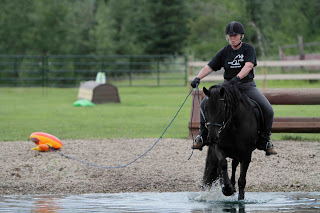Heidi's Top 10 Equine Stewardship Practises. I don't want to tell anyone what to do, or give out free "advice". But, I do want to encourage responsible horsemen to think more deeply. Many people do not think things through, and actually say or influence others with statements that are not accurate. If horsemen took the time to think things through, they may act differently in some situations. Perhaps, these practises which I strive to abide by, may help others develop their own top 10 stewardship practises. So, what does the responsible horsemen do to demonstrate stewardship?
Number 9 - The Right Horse
Choose the right horse for you and your family - many of us luck out with our horses, and many more fall to the fate of "bad luck". Don't leave your health and safety, or your horses life in the hands of luck. I think about my first horse. My mother, who did not have experience with horses, picked my horse from an ad in the local paper. She went to see the horse at a riding stable, looked at it in the eye and saw a gentle animal, and purchased the 10 year old mare for her 10 year old daughter. The horse was probably closer to 20 years old, but turned out to be the perfect child's first pony. This was pure luck. Honestly parents, in any other activity, do you rely on "good luck" when dealing with your child's safety?
Good advice to the first time horse buyer includes taking lessons on a school horse first, do your research, join a club, consult a coach, or a friend with horse knowledge, take your time finding the right horse for you, take the horse on trial if possible. Consult a veterinarian for a pre purchase exam. Take lessons right away and keep learning and having fun. This avoids painful lessons, injury, and potentially ruining a horse and destroying the potential of a young rider. A miss matched horse and rider may well be the root cause of many an unwanted horse. One can understand a parent "getting rid" of a horse that hurt their child. I am sure they would not care where the animal went, even though, if you looked at the whole picture, the horse most likely wasn't the cause. I like to think this way. There are people who want a long term relationship with a horse and folks who want the experience of owning a horse and learning and then move onto a specialized sport. Both are great opportunities for stewardship.
For younger riders a succession plan is a good idea if you are purchasing a horse. Riders need to develop their skills as a rider, then may want to specialize in an equine sport later, potentially needing a different or second horse. A good investment in the right beginners horse, is an opportunity to teach your young rider about following the plan, and what is best for their equine partner. I met a mother at a horse show and commented how amazing the little pony her young daughter was riding. She said, that pony had taught her older daughter first, and is now giving her younger daughter the confidence to become the rider she wants to be. Then, I heard from the mom, there is a line up of young riders waiting for the chance to buy the pony and learn from it. That pony has a waiting list of partners, at age 20. One valuable pony, and those riders the pony trained, now need a younger horse that can do what they want to do. The owners have a chance to work at selling the pony, but also making sure it continues to be cared for in a responsible way. Here is an opportunity to explain to a new owner, this pony made my daughters into the riders they are, and will now teach and take care of your child. Treat the pony right, I need you to make sure that one day that pony has a home where it can live out its days and simply be cared for kindly and with compassion.
I also have met older riders both experienced and new to the sport, who just want a reliable, sound and pleasant mount, maybe something fancy, but a horse that is ready to do the job. I like to think this way, if a person was 50 when they purchased a 5 year old horse today, they will be 70 years old when that animal is 25 - that is a long time to commit to an animal and that horse may live even longer than that! Ask yourself, am I prepared for that? Is there specific direction in my will for my horses? A little patience at first will eliminate the risk of riding an unproven or inexperienced horse when you are really looking for something different. Ask yourself, do I value my health and safety to the extent that I would spend the money required on a horse that is truly ready to be my equine partner for life? At 50, I will do anything I can to minimize having to spend time recuperating from a fall. Don't get me wrong, falls happen, it is part of the sport and I am willing to take it, even at 50. I am also smart enough to know how to minimize the chances of it happening, what horses to avoid, when it is safe to ride, when I need help and what equipment I need to keep me and my horses healthy. I cheap out on fancy going-out-on-the town clothing, the number of bathrooms in my house and other luxuries; I spend my dollars on good horses, good trainers and good equipment - safety and fun first!
 |
|
Choose a horse that you can have fun with right away - do you want to go to horse shows, or try out extreme trail? |









